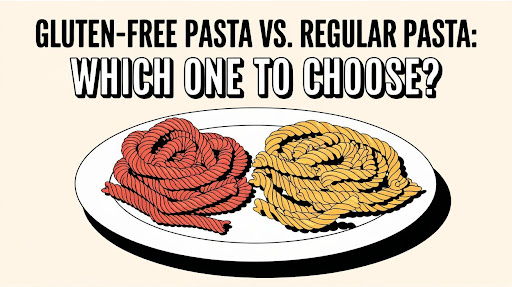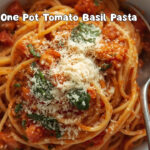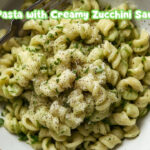Table of Contents
ToggleThe discussion about Gluten Free Pasta vs Regular Pasta has been increasing over time, but people have strong opinions about traditional pasta. Still, one thing’s for sure: gluten-free pasta is in a league of its own and is made with simple ingredients so that you can create allergy-friendly comfort food recipes.
Traditional pasta made from wheat isn’t the best choice for people who are gluten intolerant. That means those people have to refrain from some of their favorite foods. However, at Pastasphere, we believe that no one should miss out on the delicious taste of Italian cuisine! So, stay with us to discover the real insights into both pastas and the best homemade gluten-free noodles. Believe me, after trying this method, you’ll never buy store-bought noodles again.
What’s the Difference Between Gluten Free Pasta vs Regular Pasta?
But, choosing between Gluten Free Pasta vs Regular Pasta, there are numerous factors to consider. I’ve explored both options extensively. This article will delve into every aspect of these two types of pasta, from their ingredients to their health benefits, to help you make an informed decision.
What is Gluten Free Pasta?
Gluten-free pasta is designed for individuals who need to follow a gluten-free diet. This type of pasta excludes foods that contain gluten, a protein found in wheat, barley, and rye. Instead, gluten-free pasta is made from alternatives such as rice flour, corn flour, quinoa, and other gluten-free grains. These ingredients are carefully blended to create a texture and flavor similar to regular pasta.
Just like regular pasta, gluten-free pasta comes in a variety of shapes and sizes. This allows those with gluten-related disorders to enjoy their favorite pasta dishes without compromising on taste or texture. Whether you’re making a classic Alfredo or a vibrant primavera, there’s a gluten-free option available.
What is Regular Pasta?
Regular pasta is made from unleavened dough, typically using durum wheat flour mixed with water. This type of pasta is a staple food in Italian cuisine and is enjoyed by people in many countries. The dough can be produced by hand or with simple machines, and it comes in various forms, both dried and fresh.
Regular pasta is incredibly versatile, available in over 310 specific forms. These include various shapes and varieties that are perfect for different pasta dishes, pasta sauces, and pasta salads. From spaghetti to fusilli, each shape serves a unique purpose in the culinary world.
In traditional Italian cuisine, regular pasta is often paired with simple yet delicious ingredients. One of the most iconic dishes is pasta with tomato sauce, which is both easy to prepare and beloved in Italy. Regular pasta can also be found in a variety of other recipes, from classic carbonara to hearty Bolognese.
Here, I’m providing a YouTube video that discusses the differences between gluten-free and regular pasta. The creator shares personal experiences and cooking tips. It’s a helpful watch for anyone considering gluten-free options!
Texture & Taste
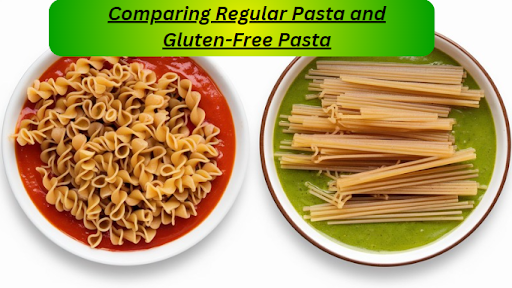
One of the biggest differences I’ve noticed between regular pasta and gluten-free pasta is in their taste and texture. Regular pasta, made from durum wheat, has a firm texture and a slightly nutty flavor that I really enjoy. On the other hand, gluten-free pasta can vary a lot based on what ingredients are used. Some brands offer gluten-free options that have a similar texture to regular pasta, but others can be softer or even a bit brittle. I’ve found that trying different brands can help you discover the ones you like best.
- Corn pasta: Little sweet flavour and tighter texture can become grainy if overcooked.
- Rice pasta: Mild flavour, tends to have a softer texture, and can become mushy if overcooked.
- Quinoa pasta: Nutty flavour, firm texture, holds up well in various pasta dishes.
- Legume pasta: An earthy flavour, a dense texture, and higher protein and fibre.
Types of Gluten-Free Pasta
There are lots of gluten-free pasta options available, made from corn, rice, chickpeas, lentils, and more. But at Pastasphere, we focus on two amazing types without compromising taste just like traditional pasta!
Corn and Rice Blend
This is certified gluten-free pasta made from a balanced blend of 70% non-GMO corn and 30% rice. It delivers a classic pasta taste and texture that’s both satisfying and delicious. Produced in a dedicated gluten-free facility, it’s completely safe for those with gluten sensitivities — no risk of cross-contamination.
Whole Grain Brown Rice
Made with 100% non-GMO whole grain brown rice flour, this certified gluten-free pasta is a wholesome alternative with a rich, nutty flavor and firm bite. It’s perfect for holding onto hearty sauces and works beautifully in a variety of dishes. Like all our gluten-free pastas, it’s made in a dedicated facility with no risk of cross-contamination.
Nutritional Comparison
Regular pasta is a good source of carbohydrates and some protein, it is often criticized for having low micronutrient content due to the refining process. During this process, parts of the grain are removed, leading to a lost of essential vitamins and minerals.
On other hand nutritional content of gluten-free pasta can vary depending on the ingredients used. Some varieties are enriched with additional nutrients to make up for the lack of gluten, while others might be low in micronutrient content. Despite this, gluten-free pasta is essential for those with conditions like coeliac disease or a wheat allergy. The primary differences between gluten free pasta vs regular pasta are:
- Rice-based pasta tends to be low in fibre and protein but mainly enriched with vitamins and minerals.
- Corn-based pasta has a slightly higher protein content than rice pasta but may lack other nutrients.
- Legume-based pasta is generally high in protein and fibre, making it the most nutritious alternative (like lentil pasta).
Why Eat Gluten Free?
A gluten-free diet is medically necessary for individuals with coeliac disease or non-celiac gluten sensitivity. Consuming gluten can cause severe health issues for these individuals, making gluten-free pasta a vital alternative. Additionally, some people choose gluten-free pasta as part of a health-conscious lifestyle, believing it to be a healthier option. Here are the most common reasons:
- Gluten intolerance—those who suffer from gluten intolerance often experience belly pain and become bloated after eating gluten-containing foods such as regular pasta.
- Allergies—Celiac disease patients cannot adequately digest gluten. For these people, gluten consumption triggers an immune reaction in the small intestine, which can negatively impact the proper absorption of nutrients in the small intestine, leading to gastric distress.
- Lifestyle Preferences—For others, the decision to go gluten-free could be due to lifestyle choices rather than intolerances or allergies and decreasing the amount of gluten consumed based on personal preferences rather than dietary needs.
Is Gluten Free Pasta Healthy Than Regular?
Although some conflict exists regarding these kinds of pasta’s health benefits, they can all be included in a healthy diet. Choosing between gluten free pasta vs regular pasta often depends on personal needs and preferences. When it comes to health, both brown and white rice pasta are great for your digestive system.
Brown rice includes the bran and the germ of the grain, which contribute to it having more nutrients and higher fibre content. Those diagnosed with celiac disease or another similar digestive issue might have difficulty digesting the brown rice until it is completely healed. However, the best choice can differ based on how an individual tolerates various legumes and beans. So, if they can be easily digested, all gluten free noodles are healthy, and you can enjoy the benefits of gluten-free pasta.
From now, I will share my personal experiences and observations regarding the differences I’ve noticed between gluten free pasta vs regular pasta. This will include insights on taste, texture, and overall cooking experiences.
Tips For Cooking Gluten Free pasta
Cooking regular pasta is pretty simple for me—just boil it in salted water until it’s al dente. However, I’ve learned that gluten-free pasta can be a bit more tricky. It often requires careful timing to avoid getting mushy. Some gluten-free pasta now cooks and tastes a lot more like traditional pasta, making meal prep easier.
Here are some valuable tips to remember when cooking gluten-free pasta:
- Always read the cooking instructions before you start and consider the amount of water and the recommended cooking time.
- Use a large pot so the pasta has plenty of space to move around—gluten-free pasta is stickier than regular pasta.
- Stir the pasta instantly after adding it to the boiling water, and keep stirring after every minute or two.
- Check the pasta for doneness after about 5 or 6 minutes, depending on the ingredients. Some gluten-free pasta cooks quickly.
- Reserve about ½ to 1 cup of the starch water before draining your pasta, and use it to moisten the drained pasta in the pot if you’re not adding sauce right away
Here, I’m providing a YouTube video that explores gluten-free pasta options. The creator shares cooking tips and conducts taste tests to compare them with regular pasta. It’s a great resource for anyone interested in trying gluten-free alternatives!
Myths About Gluten-Free Pasta
Gluten-free pasta is healthier. While it is not necessarily any more or less healthy than other pasta types, it is a better option for those with wheat intolerances. The nutrient profiles stay very similar.
Gluten-free means low-carb. It’s a common myth that some gluten-free pasta alternatives are low-carb. Any pasta made with vegetables is considered low-carb and often tastes very different from the original taste. However, gluten-free pasta replaces one carb source with another, so the flavour profile and carb content remain the same.
It doesn’t taste good. Gluten-free pasta is nearly similar to regular pasta noodles! The only differences reported are that gluten-free types are a little grainier and have a more robust, nutty flavour that pairs deliciously with any sauce.
It’s hard to cook. Gluten-free pasta can be cooked as easily and quickly as wheat pasta. There’s no risk of mushy pasta with the fantastic blend of corn and rice. The only difference is that the whole grain rice pasta takes longer to cook as the grain must be smashed down. For the best results, never rinse the pasta after cooking. Cooking gluten-free is hard; it couldn’t be further from the truth!
3 Easy Gluten-Free Pasta Recipes
The good news is mastering gluten-free pasta can be as quick and easy as cooking regular pasta. The key is choosing a trustworthy brand that matches your taste and the preparation method you enjoy.
Feta Penne Pasta Bake
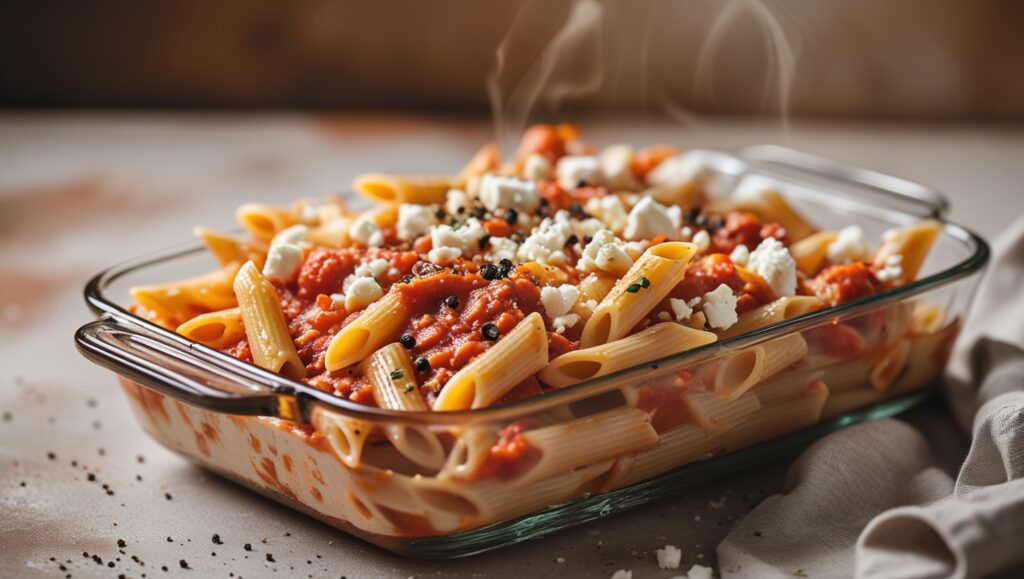
Ingredients:
- Gluten-free pasta (1 box)
- Cherry tomatoes (2 pints)
- Olive oil (½ cup)
- Salt and pepper ( according to taste)
- Feta cheese (8 ounces)
- Minced garlic (2 cloves)
- Red pepper flakes (¼ teaspoon)
- Fresh sliced basil (¼ cup)
Instructions:
- Preheat the oven to 400°F.
- Combine the olive oil and cherry tomatoes in a medium baking bowl, season with salt and pepper to taste, and toss well to coat.
- Lay the tomatoes in a 3-quart baking dish and make a well in the center.
- Fill the well with feta cheese and season with crushed pepper.
- Bake for 30 minutes until the feta starts softening.
- Raise the oven temperature to 450°F and cool for another 10 minutes until the feta and tomatoes get browned.
- Meanwhile, bring a large pot of salted water to boil and add the gluten-free penne.
- Cook the penne to al dente, then drain, reserving ½ cup of the pasta water.
- Pull the baking dish from the oven and mix the garlic and red pepper flakes.
- Stir the tomatoes and feta into a creamy sauce, then mix in the pasta.
- You can thin the sauce, if needed, with the pasta water.
- Adjust the seasoning to taste, garnish with fresh basil and serve immediately.
Gluten-Free Pasta Salad
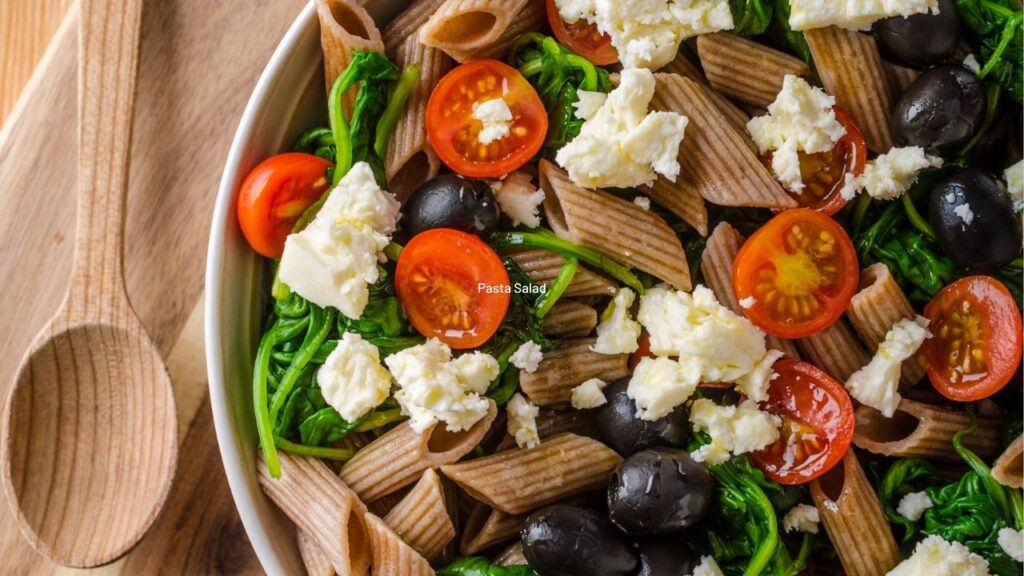
Ingredients:
For salad
- 1 package Gluten-Free Whole-Grain Rice Fusilli (12-ounce)
- 1 jar halved Olives (10.6-ounce)
- 1 pint halved cherry tomatoes
- 1 cup chopped basil leaves
- 1/3 cup toasted Pine Nuts
- 1 lemon Zest
Dressing
- 1/4 cup Golden Sweet Vinegar
- 1 tablespoon basil
- 1 teaspoon Lemon Juice
- 1/4 teaspoon Sea Salt
- 1/8 teaspoon freshly ground pepper
- 3/4 cup Extra Virgin Olive Oil
Instructions
- Serve at room temperature.
- Bring a large pot of salted water to a boil over high heat. Cook pasta according to the package instructions. Drain and rinse to stop sticking. Set aside in a large bowl.
- To create the dressing for the salad, mix vinegar, pesto, lemon juice, salt, and pepper in a bowl. Slowly whisk in olive oil to combine.
- Combine cooled pasta with olives, tomatoes, basil, pine nuts, and lemon zest in a large serving bowl. Add in the dressing and gently toss to coat.
One-Pot Veggie Pasta

Ingredients:
- 1 box Gluten-free fusilli
- 2 ½ cups water
- 1 ½ cups pasta sauce
- 1 pint cherry tomatoes, halved
- 1 small yellow onion, sliced thin
- 1 small zucchini, halved and sliced
- 1 cup sliced mushrooms
- 3 cloves minced garlic
- ½-1 teaspoon red pepper flakes (optional)
- ½ teaspoon salt
- 4 ounces fresh baby spinach
- Grated parmesan to garnish
Instructions:
- Serve immediately with grated parmesan cheese.
- Combine the ingredients in a large, deep pan. Except for the spinach.
- Bring all the ingredients mixture to a boil over high heat.
- Once boiling, lower the heat to medium-low and cook until the pasta is al dente for 10-14 minutes.
- Stir the pasta every few minutes to keep it from sticking.
- Stir in the spinach and remove from heat.
- Rest the pasta for a minute or two until the spinach is wilted.
Conclusion: Gluten Free Pasta vs Regular Pasta
Opting between Gluten Free Pasta vs Regular Pasta depends on individual dietary needs and preferences. Both have their unique characteristics, nutritional profiles, and health benefits. As someone who loves pasta, I’ve found joy in both types and appreciate the variety they bring to my meals. Whether you need to avoid gluten or enjoy traditional pasta, there are delicious options available for everyone. Explore, experiment, and enjoy the wonderful world of pasta in all its forms!
FAQs About Gluten Free Pasta vs Regular Pasta
1: What are the main differences between Gluten Free Pasta vs Regular Pasta?
The main differences lie in their ingredients and effects on the humans body. Regular pasta is made from gluten-containing wheat, while gluten-free pasta uses alternatives that don’t contain gluten. This makes gluten-free pasta suitable for individuals with gluten intolerance or coeliac disease.
2: Are there any additives in gluten-free pasta?
Yes, many gluten-free pastas include food additives such as binding agents to improve texture. Some may also contain preservatives and thickeners to enhance shelf life and consistency. It’s important to check labels for ingredients like dextrin, which can be used as a flavoring, stabilizing, or thickening agent.
3: Do I need to take vitamin supplements when eating gluten-free pasta?
If you follow a gluten-free diet, consider vitamin supplements. Gluten-free pasta can sometimes lack the nutrients found in whole-grain options, so supplements can help ensure you’re getting the vitamins and minerals your body needs.
4: Can gluten-free pasta be a part of a healthy diet?
Absolutely! Gluten-free pasta can be a part of a healthy diet, especially when it’s made with wholesome ingredients. However, it’s essential to look for options that are not overly processed and do not rely on unnecessary preservatives and thickeners.
5: How can I make gluten-free pasta more nutritious?
To enhance the nutrition of gluten-free pasta, consider adding vegetables or protein-rich foods to your dishes. You can also choose brands that include whole grains or fortified options to help compensate for any missing nutrients typically found in regular pasta.

